|
Reach the World - Chicago
Bringing the World into
Classrooms
“Wait…those
coordinates put you…in the middle of the Red Sea?”
she radioed in the bewildered tone of a confused
calculus student at the chalkboard.
Deadpanning, Aaron
replied, “Wait. Let me check… yes…we do appear to be
in the middle of the Red Sea.”
“I’m not sure whether
to admire you boys, or pity you,” the leader of the
single-sideband (SSB) cruisers’ radio net playfully
jabbed.
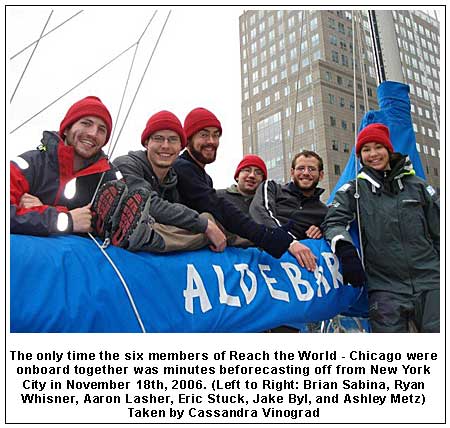 Each of the 15 other
boats in the morning radio net had called in from
the comfort of a protected bay along the Sudanese or
Egyptian coast. They were waiting out the 25 knots
of northeast breeze and accompanying short choppy
waves, characteristic of the Northern Red Sea in
late spring. Each of the 15 other
boats in the morning radio net had called in from
the comfort of a protected bay along the Sudanese or
Egyptian coast. They were waiting out the 25 knots
of northeast breeze and accompanying short choppy
waves, characteristic of the Northern Red Sea in
late spring.
Forty miles west of
Saudi Arabia, we were beating north toward the Gulf
of Suez, and making good time given the conditions.
Ever mindful not to
appear brash, Aaron explained that Aldebaran, our
1976 Swan 431, with her seven foot fin keel,
overbuilt glass hull, and 16mm rigging, is a race
horse to weather. Plus, one of the luxuries of
having five people on board is the ability to
hand-steer tough passages and still get some sleep.
Sixteen thousand sea miles behind us, we had little
left to prove. We did, however, have a schedule to
keep.
Aldebaran and her
crew were anything but the typical round-the-world
cruising boat. Most circumnavigations are Mom and
Pop operations. Having bought a boat and prepared
for years, couples put their lives on hold and chase
four to seven years worth of sunsets west.
We
were six twenty-somethings, one year out of college,
trying to make it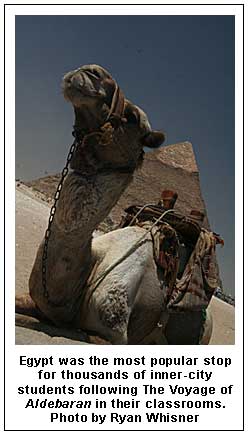 around in two years. Imagine the
Doogie Howsers of the cruising circuit. We bought
Aldebaran on a loan split six ways, and spent three
intense months massaging out the major problems
before casting off in November of 2006. With minimal
prior blue-water experience, we rabidly asked
questions, got lots of help, and learned quickly.
Three months in, our above standard safety measures
and seamanship were matters of personal pride. around in two years. Imagine the
Doogie Howsers of the cruising circuit. We bought
Aldebaran on a loan split six ways, and spent three
intense months massaging out the major problems
before casting off in November of 2006. With minimal
prior blue-water experience, we rabidly asked
questions, got lots of help, and learned quickly.
Three months in, our above standard safety measures
and seamanship were matters of personal pride.
Following the
standard route, known as the Coconut Milk Run, we
sailed (generally) east to west downwind across the
little latitudes and through both canals.
The biggest
difference between us and other cruisers was the
purpose of our journey. Each week, 4,000 inner-city
students from Chicago and New York City Public
Schools laughed, imagined, and learned about far off
cultures and environments through our crew. Their
classrooms followed The Voyage of Aldebaran online
as part of the educational programs of Reach the
World (www.reachtheworld.org).
“How did y’all get
involved with Reach the World, and can I go next
year?” asked Darrel, a third grader from Henderson
Elementary on Chicago’s Southside during a classroom
visit this past June. (We personally visit all of
our partner classrooms in Chicago at the beginning
and end of each school year.)
“Wow, great
question!” I laughed, slightly surprised. “That’s a
sixth grader question!” Darrel beamed. In truth,
it’s a question we got from people of all ages.
In the spring of
2004, the six of us (Aaron, Ashley, Eric, Jake, Ryan
and Brian) were juniors on the Northwestern sailing
team. We decided we wanted to do something special
when we graduated. We wanted to sail around the
world, but we wanted to do it in a way that also
made a difference.
A year later, after some trial and error, we founded
Reach the World - Chicago, the first branch of a New
York City b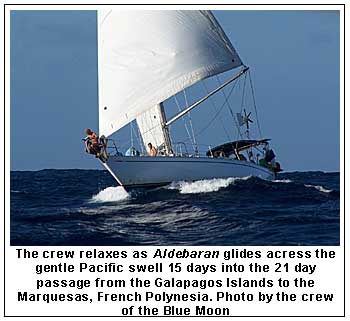 ased non-profit called Reach the World.
Reach the World’s mission is to integrate exciting
social studies and science material into
under-resourced elementary and middle school
classrooms, broadening students’ worldviews and
helping them learn with technology. In Chicago, we
achieved this goal by linking students to The Voyage
of Aldebaran. ased non-profit called Reach the World.
Reach the World’s mission is to integrate exciting
social studies and science material into
under-resourced elementary and middle school
classrooms, broadening students’ worldviews and
helping them learn with technology. In Chicago, we
achieved this goal by linking students to The Voyage
of Aldebaran.
Planning and
executing our trip through Reach the World
fundamentally changed our experience. For one, at no
point in the journey were all six of us on
Aldebaran. At least one person was always in Chicago
running the company. During summer break, four
people flew home to visit classrooms and fundraise.
We planned our route
not only around storms, winds, and currents, but
also the collective attention spans of 7-12 year
olds. Kids bore quickly. We could at most squeeze
three weeks of content out of one location. Usually
we only stayed in places ten to fourteen days. If
most cruisers moved at a 10 minute-a-mile pace, we
were on track to qualify for the Boston Marathon. We
traded palm-lined sandy beaches and idyllic
anchorages for ports with fast internet, good
transportation, and lots to write about.
It’s true that
sailing around the world is an exercise in fixing
your boat in exotic locations. The adage doesn’t
mention all of the hours spent walking from one
small store to the next trying to locate the right
part in your best broken native tongue. I now know
“stainless steel” in six different languages.
Each week our
crewmembers were also responsible for researching
and writing educational articles for the Reach the
World website, answering student emails, collecting
data for classroom research projects, and
video-conferencing with students back in the States.
The personal connection developed between the
students and our crew was tremendous. It’s what
separated our program from being just another
website or text book. It’s what got kids excited
about learning.
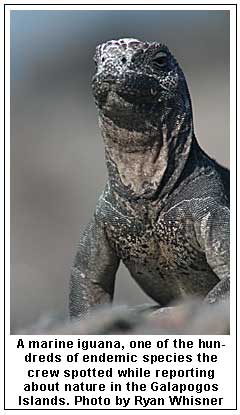 Our “jobs” (we are
unpaid volunteers) as field researchers led us into
some incredible adventures: seeing wild tigers on a
safari in India, staying in a Kuna Indian home in
the San Blas Islands of Panama, interviewing a CEO
in Dubai, visiting local schools in Ecuador,
swimming with sea lions, sharks, and penguins in the
Galapagos islands, helping out in an orphanage in
Africa, getting haircuts and shaves from displaced
Iraqi barbers in Yemen, and being taught how to make
authentic food in Thailand, to name a few. We were
always pushing to do more. Other cruisers arrived
into ports, we took them by storm. Our “jobs” (we are
unpaid volunteers) as field researchers led us into
some incredible adventures: seeing wild tigers on a
safari in India, staying in a Kuna Indian home in
the San Blas Islands of Panama, interviewing a CEO
in Dubai, visiting local schools in Ecuador,
swimming with sea lions, sharks, and penguins in the
Galapagos islands, helping out in an orphanage in
Africa, getting haircuts and shaves from displaced
Iraqi barbers in Yemen, and being taught how to make
authentic food in Thailand, to name a few. We were
always pushing to do more. Other cruisers arrived
into ports, we took them by storm.
“Lots of people told
us we were crazy,” I explained to Darrell, “but we
had a dream. We didn’t pay any attention to them. We
listen to each other, and worked hard. And yes, you
can join Reach the World, but first you have to
graduate college!”
“How far away from land do you think we are?” asked
Jake, lazily using his foot to steer the boat over
following seas during a sunset cockpit dinner. We
were five days into an 11 day passage from Thailand
to Sri Lanka. This was the type of question that
spurred wonderful humorously heated debates.
Before anyone could
conjecture, Ryan’s eyes bulged and finger shot up.
Laughing, he choked down the piece of seared fresh
yellow-fin tuna in his mouth. “About a mile…
straight down,” he said. We laughed and moved onto
one of the thousands of other seemingly mundane
topics that kept us occupied for days.
As the sun darted
below the horizon in typical tropical fashion, we
attentively watched for a green flash; we were not
to be rewarded.
“Rule 28,” said
Aaron. We all knew what it meant. Rule 28: night
time is life time - time to put on life jackets and
clip in. We had started developing rules a year
earlier to memorialize key lessons learned. We
assigned them random numbers. Rule 28 was, in fact,
the first rule instated. We all knew a handful by
heart, 43: raise your sail in the lee, 76: have a
good electric drill, etc. Rule 28 sent Eric and Ryan
below. They handed up life jackets. We handed dirty
plates and bowls down.
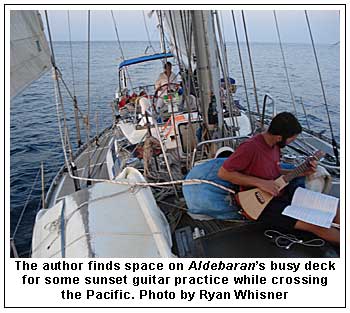 Aaron and I clipped
into the jack lines and headed forward to drop in a
reef in the main, raise the staysail, and roll in a
bit of genoa: our stable heavy air set up. Better to
sacrifice some speed and put the reefs in while
everyone is awake than be overpowered in the middle
of the night and have to call an extra person up on
deck. As I dropped the halyard and winched in the
reefing line, I remembered a time, having grown up
racing but never cruising, when this would have
seemed preposterous. Things had changed. I now
understood why one avoids upwind passages when at
all possible. Aaron and I clipped
into the jack lines and headed forward to drop in a
reef in the main, raise the staysail, and roll in a
bit of genoa: our stable heavy air set up. Better to
sacrifice some speed and put the reefs in while
everyone is awake than be overpowered in the middle
of the night and have to call an extra person up on
deck. As I dropped the halyard and winched in the
reefing line, I remembered a time, having grown up
racing but never cruising, when this would have
seemed preposterous. Things had changed. I now
understood why one avoids upwind passages when at
all possible.
My watch beeped:
eight o’clock, time to drive. (A good Timex Ironman
watch, headlamp, and polarized sunglasses are the
pantheon of personal effects to bring on an extended
cruise.) Jake relayed the vitals - average speed
over ground, wind patterns, impending changes of
course, like a doctor passing off charts at the end
of a shift. He handed me the wheel, and headed below
to fill out his log.
It was still two
hours until moonrise. The water was dark, the stars
bright. We’d been in following seas and 15-20 knots
of breeze for a couple of days. I steered the boat
by rote, listening to the wash of salty foam hitting
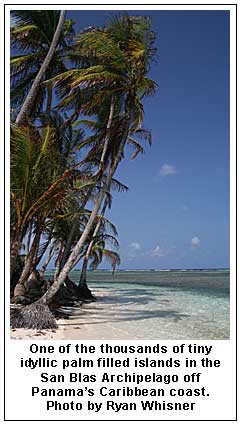 our quarter, occasionally glancing at the pedestal
compass. I thought about life and people at home. our quarter, occasionally glancing at the pedestal
compass. I thought about life and people at home.
“Ryan?” I called out looking at the orange-tinged
night sky through the window of my new bedroom in
Chicago.
“What’s wrong?” he
answered back from across the house.
“I just realized this
is the first time I’ve slept alone in a room in nine
months. It just feels weird.”
“Goodnight buddy,” he
said in a tone that let me know he understood.
Sailing around the
world before starting your adult life has only one
significant downside. You have to come back and
start your adult life. Entering back into the normal
world surfaced a lot of unexpected feelings.
Hundreds of little things were odd. There were a lot
of adjustments to make.
I had forgotten about
long summer days. In the tropics there are 12 hours
of daylight. It gets dark by 6:30 every evening, and
there is very little twilight. Direct sunshine at 8
PM was downright confusing my first day back.
I was always cold. A
couple hundred days of sunny 85-90 degree weather
thins out your blood. I felt like a flower struck by
a late spring freeze. I carried a jacket with me all
June. Air conditioned houses were hell.
Chicago streets
seemed abnormally wide, and equally abnormally
quiet. Apparently the higher a country’s per capita
GDP, the less its drivers lay on the horn.
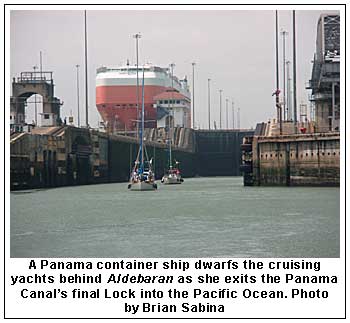 The inside jokes of a
tight knit crew were replaced by the perpetual
questions, “did you see any big waves or bad
storms?” and “what was your favorite place?” The inside jokes of a
tight knit crew were replaced by the perpetual
questions, “did you see any big waves or bad
storms?” and “what was your favorite place?”
After two months of
being back, my golden tan has started to fade and my
blood has thickened. Not much seems odd any more.
I’m no longer introduced as “Brian, who just sailed
around the world.” I’ve even gotten used to fresh
water spray again.
One thing that hasn’t faded is the quiet confidence
of being an around-the-world sailor. It never will.
Neither will the memories and kinship between our
crew, and most importantly, our desire to do it
again.
Even though The
Voyage of Aldebaran is over, Reach the World -
Chicago will continue to expand the horizons of
Chicago’s important young minds. Next year thousands
of underserved student’s will follow the RTW-C’s
Bike Africa Expedition as it pedals 7,500 miles from
Cape Town, South Africa, to Cairo, Egypt. If you
would like to support Reach the World, please see
the ad for the BIG TEAM REGATTA on page 45, or call
Brian Sabina at 773-698-6900. If you are inspired to
take a trip of your own, Aldebaran is currently on
the market in Mallorca, Spain. If you are interested
in learning more email aaron@reachtheworld.org.
Delivery can be worked out.
TOP
|